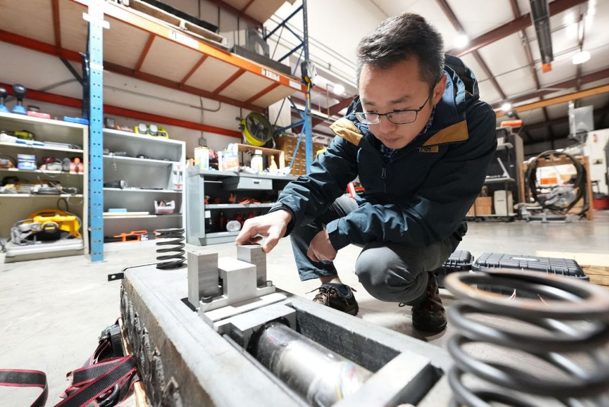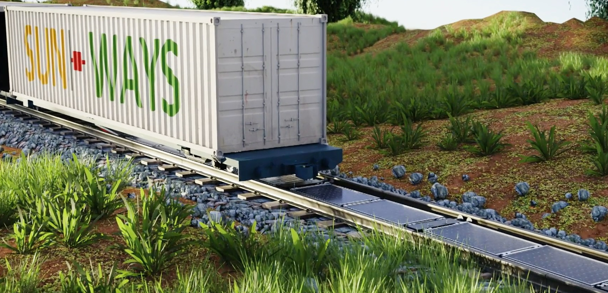Around two thirds of America’s rail tracks are in rural areas where electrical power for smart rail systems, such as wayside safety equipment, wireless communications, and track health monitors, is needed but hard to supply.
Current power sources include solar panels, which are prone to damage or theft, and generators, which need regular servicing and refueling with propane. But this could all be changing thanks to the work of researchers at Virginia Tech’s Center for Vehicle Systems and Safety (CVeSS), who have been developing a way to harness the energy created by moving trains.
Not only will this improve the durability of rail infrastructure, but it will also affect its sustainability, lowering the industry’s reliance on fossil fuels even further. “I think one of the most significant impacts of such a technology would be environmental, taking an energy that already exists in the track and turning it into something useful,” says Mehdi Ahmadian, the center’s director.
Harvesting energy
CVeSS has spent more than a decade studying energy harvesting. In recent years it’s been drawn to how this could be applied to railroads and researchers began working on an energy harvesting device that could be implemented into a rail car’s suspension.
“We started working on elements that looked like a damper or shock absorber and when the train moved the suspension would deflect by a slight amount and we’d take that mechanical energy and turn it into electrical energy,” explains Ahmadian.
This solution was successfully trialed for a year and a half, but the amount of energy harvested wasn’t significant enough and the researchers went back to the drawing board.
A track-based solution
This time they looked at developing a track-based solution, but this had challenges of its own. “We were very aware of the level of protection any solution would need if it was to be used on a track. We had to ensure it wouldn’t get damaged and after some thought, we came up with the idea of integrating energy harvesting into a key track element,” explains Ahmadian.
The result was a new high-tech railroad tie which shields two rotary electromagnetic energy harvesters. Placed under a rail and topped with a heavy metal bar mounted on a spring, as the wheels of a train pass over the rail, the weight pushes down on the bar triggering a series of gears. These rotate a generator, creating electricity.
“Track crossties were a convenient and suitable means for packaging the energy harvesting components. In addition, because they look like traditional ties, they’re less likely to interest thieves or vandals,” Ahmadian points out.
After successful proof-of-concept testing in the lab, the team developed a full-size prototype. This was installed on a Norfolk-Southern Railway track last August to begin testing the amount of energy it could harvest and look at ways the design could be optimized.
“Norfolk-Southern has a railroad track 20 minutes away from our lab. We have a long-standing relationship with them, having worked together on projects for more than 25 years. Regularly, they graciously host us on their rails so we can see how things we’ve tested in the lab do out in the field,” Ahmadian explains.
The results were positive, but testing had to be paused after six weeks when a minor fault was discovered. “Track vibrations had loosened four bolts that we discovered didn’t have enough clamping force on them. We found this out thanks to a nifty little camera that could be pushed through a small opening in the tie to see inside. It was a simple solution – some changes were made to the design to improve the clamping force and then we were ready to go again,” Ahmadian adds.

Yang Chen inspects an energy-harvesting rail in CVeSS’s Railway Technologies Laboratory. Image: by Alex Parrish for Virginia Tech
Positive early results
These six weeks, however, had already given Ahmadian and his team a good idea of how much power the tie might produce. For every axle that passed over the tie, roughly 10 watts of power was produced. In the case of a freight train with 100 railcars that would be 400 axels, which could produce around four kilowatts of energy.
“Bear in mind that when we store and retrieve this energy, we are subject to the inefficiencies of the storage system, which we don’t have numbers for yet. But if I give a ballpark figure of 50%, then from each train I will be able to get two kilowatts of usable power for operating something,” says Ahmadian.
“These are loose calculations, with a certain amount of conservatism, but you can begin to imagine how much energy could be harvested each day from a track with heavy traffic,” he enthuses.
By the time of publication, the prototype tie should be back on the track, where it will be tested for six months to ensure it’s robust enough to last and to compare energy production from different traffic conditions. After this, it will be returned to the lab in order analyze the levels of wear and tear.
Energy storage
Energy storage is also a key consideration for the team. There is the ability to house batteries within the tie itself, but some kind of connector would be needed in order to access the power from these batteries.
Another idea is to have a bank of six or eight ties, packaged within a single-track panel that could be slipped into place. With this solution it makes sense to have a central wayside storage facility for the ties, which would have the capacity to power more, or bigger, devices. “We haven’t got quite that far yet though,” says Ahmadian. “It really depends on the preference of the railroads; their needs and what alternatives are available.”
Looking forward, Ahmadian’s positive that there will be a commercial product available in just three to four years’ time. “Ultimately, we’re driving ourselves toward commercializing this product, and we’ve already had some enquiries from tie manufacturers looking to integrate this solution into their ties to offer a value-added product. There’s also been some interest in licensing a patent application that was published last October. The issuance of the patent is pending,” he explains.
Not ones to rest on their laurels, the researchers are already working on a similar energy harvesting idea for train axels. This axel generator, Ahmadian predicts, will be able to generate far more power than the team’s original railcar suspension solution. “We’re highly optimistic that this could provide enough energy for power-hungry components and is something else my team is currently working on,” he concludes.
ENDS.

Sun-Ways is expected to bring its first solar railways online in May this year. The pre-assembled panels are rolled out onto the railway in a manner similar to unrolling a carpet
Using track-based solar-panels to generate electricity in Switzerland
A similar approach of using the rail network to harvest energy is being developed in Switzerland and is set to hit the tracks this summer. For the past two years, Swiss start-up Sun-Ways and its partners have been looking at the possibility of laying solar panels between the train rails to generate electricity.
According to Baptiste Danichert, co-founder of Sun-Ways, the potential to create solar energy using this approach “is huge”. He claimed that up to 1 TWh of solar energy could be produced this way.
Sun-Ways’ approach consists of a mechanically detachable PV system, which is pre-assembled in a factory and then laid like a carpet between the tracks using a special train. It can also be easily removed to enable maintenance work. “In terms of installation, we are currently looking at placing 1km of detachable PVs per night,” says Danichert. “In the future, we hope to increase this to 4km per night.”
The company is currently gearing up to pilot the system alongside Swiss Federal Railways this summer. “We are also working with Geste Engineering for the regulatory work, Scheuchzer for the maintenance train and Meccad for the mechanical aspects,” explains Danichert. “We are currently waiting for approval from the Swiss Federal Office of Transport to begin our pilot project, which will see the system thoroughly tested on 100km of track near Neuchâtel.”
Looking at whether the energy generated from the solar panels could be directly fed back to the trains for propulsion power, Danichert says, “We can’t do this yet, as the current technology does not allow for it. But we are in discussions with one of the leaders in this field to see if we can make it possible.”
Sun-Ways also has big plans to roll out the solution beyond the borders of Switzerland. “We plan to expand rapidly,” Danichert adds. Across Europe, the railway network is approximately 260,000km long and covers 1.16 million km worldwide. According to Danichert, the company has already contacted investors in Europe and the United States to offer the solution on an industrial scale.
This article first appeared in the March 2023 issue of Electric & Hybrid Rail Technology magazine. To read the full issue, click here.

